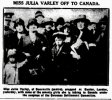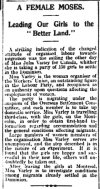From my forthcoming 'Great War Trail of Birmingham'
42, Hay Green Lane, Bournville. It has not been possible to find a wartime address for Miss Julia Varley, a leading woman trade unionist of the time. This was her address in November 1952 when she died at the age of 81. She was born at Bradford, the daughter of a worsted mill worker. She left school at twelve and became a weaver. At the age of 15 she was branch secretary of the Weavers and Textile Workers’ Union. She became the first woman member of the executive committee of the Bradford Trades Council in 1899. In 1904 she became a Bradford Poor Law Guardian. To investigate the life of tramping women she tramped from Leeds to Liverpool to find out first hand. She did the same for licensed women’s lodgings houses in London. She was twice imprisoned in 1907 as a suffragette. She now became involved with Mary Macarthur and the National Federation of Women Workers and, in particular, the cause of the women chain workers of Cradley Heath.
In 1909 Edward Cadbury invited to organise women workers at Bournville and a branch of the NFWW was established. In January 1910 she became the first woman to be elected to the executive of the Birmingham Trades Council and was to serve for ten years. In 1911 she failed to win election to the new Greater Birmingham Council after standing as a socialist in Kings Norton. By 1912 she had joined the Workers’ Union which sought to organise both sexes.
Two days after the declaration of war Julia Varley was part of a Birmingham Trades Council deputation to meet the Lord Mayor to discuss the steps which might be needed to deal with the dislocation of trade and employment created by the war. She became one of five from the Trades Council who joined the Emergency Committee. Julia was also part of Trades Council initiatives to help Belgian refugees as well as trying to ensure that their employment conformed to trade union practice. This work was praised by Vandervelde, the Belgian socialist, who visited in November 1914. During the war she served on the Munitions Tribunal and the Citizens’ Committee.
She was the only woman organiser in Workers’ Union until August 1915 and was an active organiser throughout the war despite having a major throat operation in early 1917. She disagreed with many men on the Birmingham Trades Council over the introduction of conscription which she accepted and joined a breakaway Birmingham Trade Union Industrial Council. In 1917 she was selected to serve on the Labour Advisory Board set up by the Ministry of Labour and which monitored the working of labour exchanges. In early 1918 she went to France as one of five women sent to investigate rumours of immoral behaviour by WAACs in France; they were groundless. The commission found “a healthy, cheerful, self-respecting body of hard-working women, conscious of their position as links in the great chain of the Nation’s purpose and zealous in its service”. Afterwards Julia spoke at a factory gate meeting at the Austin about the slanders on the women of the WAAC.
In 1920 Julia Varley took up the cause of female domestic servants. In 1917 there were still 1.25 million women in service, a drop of only 400000 since the war began. The fall was mainly in middle class households. In 1920 she formed in Birmingham a Domestic Servants’ Union and set up their own social club in the city at 1, Loveday Street. The Daily Chronicle called the club a ‘servants’ paradise’. A charter of appropriate conditions of work was issued which covered hours, time off, a minimum wage, their own bedroom, the mistress should pay for uniform and servants should be addressed by their proper names. Julia was a member of a 1923 Ministry of Labour enquiry into the ‘servant shortage’. She told them that one part of the problem was caused by parents wishing a better life for their daughters.
Post-war she continued to serve as the chief woman organiser of her union which became the Transport and General Workers. She was elected to the General Council of the TUC and also served on Government committees. In 1931 her public work was recognised by an OBE. In September 1935 Julia was part of a large international delegation to the League of Nations in Geneva on the subject of women’s claims for equality all over the world. She was the principal speaker of the delegation in her role on the Women’s Committee of the TUC and the International Committee of Trade Union Women. She retired from trade union work in 1936 and began to live at Hay Green Lane. As she grew older she lost her sight. She died at the home of her sisters in her native Bradford on November 24 1952 and was buried in Undercliffe cemetery there. George Haynes, a Birmingham trade unionist, had always believed that she was a ‘pocket dreadnought’.
‘Socialism in Birmingham and the Black Country 1850-1939’. George Barnsby. Integrated Publishing, 1998
‘The Birmingham Trades Council 1866-1966’. John Corbett. Lawrence and Wishart. 1966.
Oxford Dictionary of National Biography



